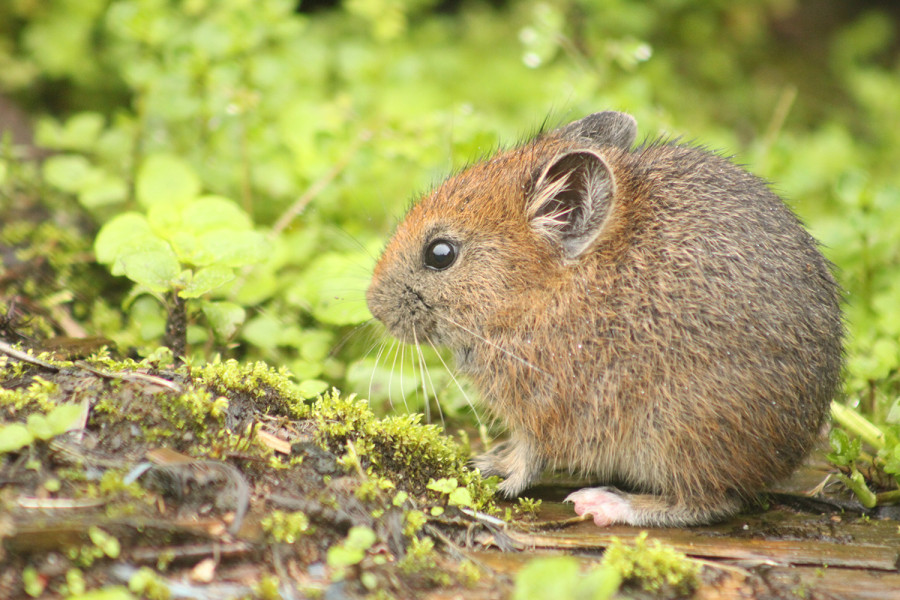Climate & Environment
Higher altitudes beckon more wildlife in Nepal amid warmer climes
Experts and independent studies have assessed warming temperatures could be a contributory factor for movement of animals and insects towards higher altitudes.
Marissa Taylor
Indra Dhara Bista remembers his childhood winters being biting cold. From December to February, the thatched roof of his home in Jomsom, a village in Gharapjhong Rural Municipality in Mustang district, would be blanketed by thick, white snow. Livestock would be kept indoors throughout the season; fed stored, sun-dried hay. When the temperature dipped too low, his family would be compelled to migrate down to lower elevation.
"But in the last decade or so, winters have become considerably warmer. And only few people move down these days,” says 50-year-old Bista, a resident of Jomsom. “Not just temperatures, but rain and snowfall patterns have also become unpredictable in recent years. Even summer temperatures are rising.”
Accompanying the changes in weather are the sightings of an insect unseen in the area before—the tiny mosquito.
“As a child, I didn’t know what a mosquito was. But now there are mosquitoes here in Mustang in the summer,” he says. The insect, which has been known to live only at a maximum elevation of 1,500m, is being sighted in higher elevations, such as in Jomsom (2,743m). Last year, they were reportedly sighted in Lo Manthang (3,840m).
Erratic weather patterns are being witnessed across the Himalayan region of the country, affecting its delicate ecology and possibly even influencing species’ habitats and biodiversity, climate change experts say. And the effects of changing climate will be exaggerated for such a geographically vulnerable region, especially considering the country’s lack of economic resources and poverty-stricken population.
Mosquitoes are not the only species that are being sighted in altitudes that were previously unheard of.
A research study titled ‘House Crow (Corvus Splendens) Heading Upwards in Nepal: Possible Climate Change Impact Influencing its Movement’, conducted from 1999 to 2011 on the movement pattern of the bird, reveals that the species is moving by an altitude of 136m annually, from 2,000m to 4,200m, on an average, in Mustang.
“There have definitely been sightings of species at higher altitudes, in Nepal and abroad. Even our research on the house crow revealed just that,” says Yadav Ghimirey, a conservation biologist and one of the authors of the report. “Increase in temperature could be a contributing factor in influencing species to adapt to the warming climate, forcing them to go upwards to survive.”
In another part of the Himalayan region in Nepal, the mountain-dwelling pika is another animal that researchers have found to be moving upwards. A three-year study (2011-13) conducted by Narayan Prasad Koju, PhD programme coordinator, MSc Natural Resources Management, in Kyanjin (3,900m) in Langtang National Park shows the lowest elevation of pika habitat has shifted up by 200m in an interval of 46 years, suggesting they are either getting locally extinct or are migrating upwards.
“Either situation could spell a disaster for the local ecosystem. Pikas are extremely temperature sensitive and are non-hibernating species, which means the slightest alterations in temperature can make them extremely vulnerable,” says Koju. “It is also a keystone species and it has an immense effect on its surrounding natural environment.”
Residents of Kyanjin Gompa, the last village in the Langtang valley, situated at 3,800m, too feel the effects of a warming climate.
“It is definitely warmer now, in the summers and winters. We are now able to grow cauliflowers in greenhouses throughout the year. This was not possible when we were children; it would be too cold to do so,” says 45-year-old Mangalmu Lama, who runs a lodge in Kyanjin Gompa all year round. “When I was a child, Kyanjin would be buried in snow five feet deep. I haven’t seen snow like that for years now,” she says.
Another study conducted on the clouded leopard in 2020 in the Langtang area found the elusive animal surviving at 3,498m. The animal has so far been found only at 2,300m.
And this kind of movement has not just been witnessed in the mountains of Nepal.
A study led by the University of Colorado, spanning nearly 13 years, published in February 2021, has reported that critters such as the golden-mantled ground squirrel, a popular sight in the Rockies, are moving up as the mountain range warms. The report stated that on an average the ranges of the ground squirrel and 46 other species of small mammals have shifted upward by more than 400 feet since the 1980s. Species living at higher elevations, like the squirrel, have moved up by 1,100 feet.
Closer to Nepal, a study by the Zoological Survey of India, released in 2019, identified at least 49 species of moth and 17 species of butterfly that have shown “considerable new upward altitude records” in the Himalayas with a difference of more than 1,000 metres between their current and previously recorded mean habitat altitudes, according to Indian news reports.
What all these changes mean for biodiversity and humanity isn’t easy to predict.
“Species move but they do not move at the same time and at the same pace, meaning all species do not respond to the same signals,” says Koju. “Some can move, some can adapt and some may die; the response of the species to a changing climate is unpredictable. But any kind of change in natural order or redistribution can have catastrophic implications on the local ecology and this will have a chain reaction.”
However, experts also say that there could be other factors at play in the movement of animals and insects.
“We cannot deny the fact that there is a basic warming trend that is being witnessed across Nepal,” says Dipesh Joshi, a climate change expert with WWF Nepal. “But there are multiple factors that could be influencing these animals to move, such as better habitat, human-influenced transportation, easier prey.”
In the same vein, Ghimire, the conservationist, too believes that it is too early to make conclusions. “To say that climate change is causing upward migration without proper, long-term research would be too rash. There is much more research needed to ascertain the biological responses towards climate change,” he says.
But research opportunities are hard to come by in a poor, under-developed nation like Nepal that is always mired in political instability.
"Changing climate and biodiversity loss are two urgent, global issues, but in a developing country like Nepal, there are other more pressing issues that need attention," says Buddhi Sagar Poudel, chief of the REDD+ Initiative, a climate change adaptation initiative under the Ministry of Forest and Environment. "Right now, when it comes to climate change, the focus of the government is more on mitigation and adaptation. We just do not have the resources to carry out long-term extensive research work.”
But if the climate continues to warm at its current rate, experts believe that consequences will be dire. According to the Intergovernmental Panel on Climate Change report titled ‘Global Warming of 1.5 degrees Celsius’, “twice as many plant species–and three times as many insects, which are critical to our food supply–could lose at least half their habitat under a 2-degree versus a 1.5-degree rise.”
“Nature is constantly changing, always evolving–that is a given. But changes in the past few decades have taken place too quickly, and we have no idea what the implications will be,” says Koju.
Back in Mustang, for people like Bista, these changes are already far too real. With the emergence of mosquitoes in mountainous regions, there has been an increase in malaria and dengue cases. A 2016 report states that since 1988, a total of 9,836 malaria cases have been reported from 13 out of 16 mountain districts—places where the disease was previously unheard of.
Changes in the climate directly and indirectly affect the lives of the people who call the mountains their home.
“These changes are subtle but they are definitely there,” says Bista. “For people who live in the mountains year-round, they are much more visible already.”
This story was written and produced as part of a media skills development programme by Thomson Reuters Foundation.




 22.65°C Kathmandu
22.65°C Kathmandu














